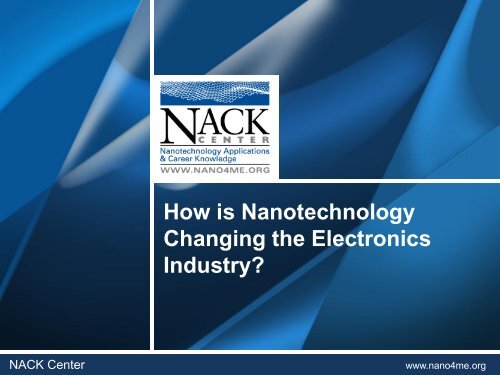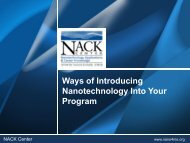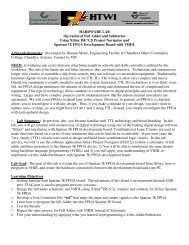How is Nanotechnology Changing the ... - MATEC NetWorks
How is Nanotechnology Changing the ... - MATEC NetWorks
How is Nanotechnology Changing the ... - MATEC NetWorks
Create successful ePaper yourself
Turn your PDF publications into a flip-book with our unique Google optimized e-Paper software.
<strong>How</strong> <strong>is</strong> <strong>Nanotechnology</strong><strong>Changing</strong> <strong>the</strong> ElectronicsIndustry?NACK Centerwww.nano4me.org
The NACK Center was establ<strong>is</strong>hed at <strong>the</strong> PennsylvaniaState College of Engineering, and <strong>is</strong> funded in part by agrant from <strong>the</strong> National Science Foundation.Hosted by <strong>MATEC</strong> <strong>NetWorks</strong> www.matecnetworks.orgNACK Centerwww.nano4me.org
Welcome to NACK’s WebinarToday’s PresenterCenter for <strong>Nanotechnology</strong> Applications and Career Knowledge (NACK)Dr. Osama AwadelkarimAssociate Director, NACKProfessor Engineering Science and Mechanics, PennState Universityooaesm@engr.psu.eduNACK Centerwww.nano4me.org
Miniaturization in Microelectronics“Physics of Semiconductor Devices”, S.M. Sze, John Wiley & Songs publ<strong>is</strong>hing, 1981
1961 The first planar integrated circuit (IC)300 mm waferSource : Bob Trew, NCSU1965 “Cramming more components ontointegrated circuits” by Intel Co-FounderGordon Moore.
Moore’s Law (continued)ftp://download.intel.com/museum/Moores_Law/Printed_Materials/Moores_Law_2pg.pdf
Source : Bob Trew, NCSU
Why <strong>is</strong> <strong>Nanotechnology</strong> importantto Microelectronics?*• The “push” in microelectronics <strong>is</strong> constantly toward smallertrans<strong>is</strong>tors. Th<strong>is</strong> allows faster and more devices on a chipgiving more memory and more functionality; i.e., giving newproducts to sell.• The microelectronics industry has reached more than abillion trans<strong>is</strong>tors on a chip! Trans<strong>is</strong>tors in production aresmaller than 45nm!• Today’s advanced devices require that <strong>the</strong> microelectronicsindustry uses nanotechnology everyday to make <strong>the</strong>setrans<strong>is</strong>tors.*Source : S. J. Fonash, class notes, Penn State UniversityCopyright 2012 Center for <strong>Nanotechnology</strong> Education and Utilization
Why <strong>is</strong> <strong>Nanotechnology</strong> importantto Microelectronics? (ctd.)*• According to Dr. Andrew Moore (afounder of Intel) <strong>the</strong> number oftrans<strong>is</strong>tors on a chip doubles aboutevery 18 months.• Th<strong>is</strong> observation <strong>is</strong> known asMoore’s Law.• It captures <strong>the</strong> speed with whichmicroelectronics companies havebeen pushing each o<strong>the</strong>r to smallerand smaller trans<strong>is</strong>tors.Source : Bob Trew, NCSUCopyright 2012 Center for <strong>Nanotechnology</strong> Education and Utilization
Why <strong>is</strong> <strong>Nanotechnology</strong> importantto Microelectronics? (ctd.)*• The microelectronics industry <strong>is</strong> using top-downnanofabrication to make its nano-scale advancedtrans<strong>is</strong>tors.• All <strong>the</strong> deposition, lithography, material modification, andetching steps required by top-down fabrication meancleanrooms and very expensive equipment are required.These equipment requirements get more stringent as <strong>the</strong>trans<strong>is</strong>tors get smaller.Copyright 2012 Center for <strong>Nanotechnology</strong> Education and Utilization
Fab cost ($B US)Why <strong>is</strong> <strong>Nanotechnology</strong> importantto Microelectronics? (ctd.)*• The fabrication facilities (called “fabs”)for making <strong>the</strong>se trans<strong>is</strong>tors get moreexpensive as <strong>the</strong> trans<strong>is</strong>tors getsmaller.• Dr. Moore also notice a trend in th<strong>is</strong>cost. H<strong>is</strong> observation was that <strong>the</strong> costof building a new fab doubled everythree years.• Th<strong>is</strong> observation <strong>is</strong> called Moore`sSecond law.*Source : S. J. Fonash, class notes, Penn StateMoore’s Second Law100101Doubling time~ 3 years0.11990 1995 2000 2005 2010 2015Year of ConstructionSource : Bob Trew, NCSUCopyright 2012 Center for <strong>Nanotechnology</strong> Education and Utilization
Fab cost ($B US)Microelectronics <strong>is</strong> not a silicon technology somuch as it <strong>is</strong> a lithography technology• Problem:– Device down-scaling and<strong>the</strong> prohibitive cost oflithographyMoore’s Second Law10010Doubling time~ 3 years• Fundamental <strong>is</strong>sues:– Devices todaylithographically determined(top-down fabrication)– Interconnects (can not takeup all <strong>the</strong> real estate)1by 2025- 1.5 meter wafer- 27 level metal0.11990 1995 2000 2005 2010 2015Year of ConstructionSource : Bob Trew, NCSUCopyright 2012 Center for <strong>Nanotechnology</strong> Education and Utilization
Front-End of <strong>the</strong> Line IssuesSourseGateI 3 I 4Drainn + n +I 2I 6I 1p-wellI 5Substrate• Direct tunneling and gate leakage : Thermal SiO 2 <strong>is</strong> no longer a suitable gatedielectric– Problem : as t ox decreases below 30 Å quantum mechanical tunneling acrossSiO 2 <strong>is</strong> significantly enhanced.– Solution : use of high dielectric constant (high-k) materials for <strong>the</strong> gate dielectricinstead of SiO 2 .• Potential high-k are SiN x O y , TiO 2 , SrTa 2 O 6 , ZrSiO 4 , HfO 2 , BST etc. (k HKvalues between 4 and 100).Copyright 2012 Center for <strong>Nanotechnology</strong> Education and Utilization
High-k Materials for SiO 2 in GateDielectricsCkoxoxkoxotox 3.9AGateando 8.851014F/ cmCox CHKktHKHKoGateandEffective Oxide Thickness ( EOT ) A3.9kHKtHKCopyright 2012 Center for <strong>Nanotechnology</strong> Education and Utilization
Back-End of <strong>the</strong> Line Issues• Conventional (IC generations of L > 0.25mm) passivation and multilevelmetallization use Al for <strong>the</strong> metalinterconnects and SiO 2 (TEOS) for <strong>the</strong>interlayer dielectric (ILD).• Problems :– RC interconnect delayRCdelaym k ILD– Power consumption2CVPower 2fkILDYasuo Wada, Prospects for Single Molecule Information Processing Devices, IEEE, Vol. 89 No. 8, August 2001 Pg. 1147-1171
Solutions• Al <strong>is</strong> replaced by Cu .r Al ~ 3 - 5 Wcm and r Cu ~ 1-2 Wcm• SiO 2 <strong>is</strong> replaced by a low-k ILD : present IC generationsuse low-k polymers.
Alternatives : NewArchitectural ApproachesLinda Geppert, The Amazing Van<strong>is</strong>hing Trans<strong>is</strong>tor Act, IEEE Spectrum, October 2002, Vol. 39, Number 10, pg. 28-33
Alternatives : New FabricationApproaches• Many people have suggested that <strong>the</strong>microelectronics industry has to stop using topdownnanofabrication and must move to bottom-upor hybrid nanofabrication.• If th<strong>is</strong> worked, it would stop <strong>the</strong> spiraling costs ofproducing nano-scale trans<strong>is</strong>tors.Copyright 2012 Center for <strong>Nanotechnology</strong> Education and Utilization
New Fabrication Approaches• Two approaches have been proposed:1. Microelectronics based on nanoparticles.Th<strong>is</strong> has been termed nanoelectronics.2. Microelectronics based on <strong>the</strong> ultimatenanoparticles-- molecules. Th<strong>is</strong> has beentermed molecular electronics(moletronics).Copyright 2012 Center for <strong>Nanotechnology</strong> Education and Utilization
Nanoelectronics• Devices start small– Nanoparticles are “born” small– No need for etching– Position with self-assembly; <strong>the</strong>n no need forlithography• Possible new device physics– Very small structures possible—th<strong>is</strong> givesr<strong>is</strong>e to quantum confinement effects– New types of devices possible* Source : S. J. Fonash class notes, Penn StateCopyright 2012 Center for <strong>Nanotechnology</strong> Education and Utilization
Moletronics• Devices start very small– Molecules are inherently small– No need for etching– Position with self-assembly; <strong>the</strong>n noneed for lithography• Possible new device physics and chem<strong>is</strong>try– New types of devices possibleCopyright 2012 Center for <strong>Nanotechnology</strong> Education and Utilization
Where are we with <strong>the</strong>se alternatives?• Generic solution proposed:– Use bottom-up nanofabrication (lots of selfassembly)and avoid lithography• Present state-of-<strong>the</strong>-art:– Nanowire and nanotube demonstrations– Molecular device demonstrations• Challenge:– Make complex self-assembled circuitsCopyright 2012 Center for <strong>Nanotechnology</strong> Education and Utilization
Building Blocks forNanoelectronics• Nanowires• Nanotubes• Quantum dotsCopyright 2012 Center for <strong>Nanotechnology</strong> Education and Utilization
Vapor-Liquid-Solid Growth of SiNanowiresSi-source gas flowAu catalystSiSiSubstrateMolten eutectic alloy droplet at relatively lowtemperatures (363 o C)SubstrateLiquid alloy acts as a preferred sink orcatalyst for arriving vaporcatalystSiNWSubstrateEutectic liquid become supersaturated and Siprecipitates out at a solid-liquid interfaceSubstrateNanowire grown by VLSCopyright 2012 Center for <strong>Nanotechnology</strong> Education and Utilization
(J. Appl. Phys. 103, 2008, p. 024304)Copyright 2012 Center for <strong>Nanotechnology</strong> Education and Utilization
Carbon Nanotubes• Carbon nanotubes (CNTs) belong to <strong>the</strong> fullerenefamily. Fullerenes are composed of covalently bodedC atoms arranged to form a closed, convex cage.The first of <strong>the</strong>se molecules C60 was reported inNature 1985 by Rice University team (Nobel Prize1996). C60 d<strong>is</strong>tinctive soccer ball structureresembled architect Buckminster Fuller’s geodesicdomes winning <strong>the</strong> name “buckminsterfullerene”.• CNT <strong>is</strong> accredited to Sumio Iijima from NEC Corp. in1991.Copyright 2012 Center for <strong>Nanotechnology</strong> Education and Utilization
Carbon Nanotubes: Geometry• SWNT can be imagined to be a sheet that has been wrappedinto a seamless cylinder.• A typical SWNT diameter <strong>is</strong> 1.5 nm. It <strong>is</strong> less common thatSWNT diameter <strong>is</strong> 1 nm or less, and larger tubes are generallymore stable than small ones.• SWNTs might be hundreds of nm long (aspect ratios <strong>is</strong> on <strong>the</strong>order of 1000) and are closed at both ends by hem<strong>is</strong>phericalcaps. Half of a C60 molecule <strong>is</strong> <strong>the</strong> correct cap for large tubes.• MWNTs are typically tens of nanometers in diameter and <strong>the</strong>spacing between <strong>the</strong> layered shells in <strong>the</strong> radial direction of <strong>the</strong>cylindrical CNT <strong>is</strong> approximately ~ 0.3 nm.Copyright 2012 Center for <strong>Nanotechnology</strong> Education and Utilization
(A) The wrapping of a graphenesheet into a seamless SWNTcylinder.(B) and (C) show <strong>the</strong> aggregation ofSWNT in a supramolecular bundles.The cross-sectional view in (C)shows that <strong>the</strong> bundles havetriangular symmetry.(D) A MWNT composed of nestedSWNTs.(E) At <strong>the</strong> macromolecular scale,bundles of SWNTs are entangles.Copyright 2012 Center for <strong>Nanotechnology</strong> Education and Utilization
Selected Character<strong>is</strong>tics ofSWNTsTypical diameterTypical lengthIntrinsic bandgap(metallic/semiconducting)Work functionRes<strong>is</strong>tivity at 300 K(metallic/semiconducting)1-2 nm100-1000 nm0 eV/~5 eV~ 5 eV10 -4 -10 -3 Wcm/10 WcmTypical field em<strong>is</strong>sion current density 10-1000 mA cm -2Thermal conductivity at 300 K 20-3000 W m -1 K -1Elastic modulus1000-3000 GPaCopyright 2012 Center for <strong>Nanotechnology</strong> Education and Utilization
Carbon Nanotube Trans<strong>is</strong>tor(Pt)(Pt)Tans, et al., Nature, 393, 49, 1998Martel et al., APL, 73, 2447,1998
Measurement of Interface States inSilicon NW Trans<strong>is</strong>tors• Charge pumping (CP) <strong>is</strong> a very powerfultechnique for measuring interface states,D it , in trans<strong>is</strong>tors. Th<strong>is</strong> <strong>is</strong> <strong>the</strong> first time amodified 3-terminal CP version (3T-CP)<strong>is</strong> applied to SiNWFETs.• Axially doped (n + -p - -n + ) SiNWs are grownusing vapor-liquid-solid methods to adiameter ~ 46 nm as determined byFESEM.• Oxide ground <strong>the</strong>rmally in O 2 ambient at800 °C for 45 mins to form a uniform 8-nm thick shell.• The n + ends of <strong>the</strong> NW are aligned ontoTi/Al contacts and a surround Al gate(200 nm) <strong>is</strong> deposited.K. Sarpatwari, O. O. Awadelkarim etal., IEEE Trans. <strong>Nanotechnology</strong>, 10(4), 871 (2011)
Colloidal Syn<strong>the</strong>s<strong>is</strong> of Quantum DotsVacuumArgon flowThermometerTo hoodTemperaturecontrollerpowerJ. Xu, PSU Seminar, 2008
Semiconductor Quantum Dots:Device QualityGreenQDsYellowQDsOrangeQDsRedQDs3 nm 5.5 nm 7.5 nm 8.3 nm530 nm 570 nm 590 nm 620 nmCore/ShellstructureAbsorption(nm)CdSe/ZnSCdSe/ZnSCdSe/CdS/ZnS506 546 577 600PL (nm) 527 567 589 620FWHM(nm)QY: asprepared*QY purifiedfor QD-LED*25 28 22 21CdSe/CdS/ZnS>70% >70% >70% >70%10 % 30% 40 % 35%J. Xu, PSU Seminar, 2008
Absorbance (a.u.)Photoluminescence (a.u.)Solar Cells : Hybrid Infrared NQD-PolymerPhotovoltaic Devices2AbsorbancePhotoluminescence215.0nm6.0nm7.8nm101200 1500 1800 2100Wavelength (nm)0J. Xu, PSU Seminar, 2008
Building Blocks for Moletronics• Molecules that show--– Reconfiguration– Redox reactions– Electron transport– Tunneling– Mechanical stress effectsCopyright 2012 Center for <strong>Nanotechnology</strong> Education and Utilization
Moletronics Device Fabrication• Hopefully selfassembly• Probably hybridS. M. Lindsay, “Single Molecule Electronics”, The Electrochemical Society Interface, Spring 2004
<strong>How</strong> Can We Better Serve You?Whe<strong>the</strong>r you are joining us live or watching<strong>the</strong> recorded version of th<strong>is</strong> webinar, pleasetake 1 minute to provide your feedback andsuggestions.http://questionpro.com/t/ABkVkZLohwNACK Centerwww.nano4me.org
Webinar RecordingsTo access th<strong>is</strong> recording and slides v<strong>is</strong>itwww.matecnetworks.orgKeyword Search:“NACK Webinar Nano in Electronics”NACK Centerwww.nano4me.org
Upcoming NACK Events – 2012March 30:WebinarApril 16-19:WorkshopApril 27:WebinarMay 1-3:WorkshopBuilding a <strong>Nanotechnology</strong>Workforce<strong>Nanotechnology</strong> CourseResource I: Safety, Processes,and Materials<strong>Nanotechnology</strong> and MaterialsHands-on Introduction to<strong>Nanotechnology</strong> for EducatorsV<strong>is</strong>it www.nano4me.org for more detailsabout <strong>the</strong>se and o<strong>the</strong>r upcoming webinars and workshops.NACK Centerwww.nano4me.org
Thank you for attending <strong>the</strong>NACK Center webinar<strong>How</strong> <strong>is</strong> <strong>Nanotechnology</strong><strong>Changing</strong> <strong>the</strong> Electronics Industry?NACK Centerwww.nano4me.org








